Strawberries
Charcoal Rot of Strawberry: Increasing Problem in California
Beginning at least as early as 2005 and continuing through 2013, collapsing strawberry plants from various parts of California have been associated with the soilborne fungus Macrophomina phaseolina. The disease, called charcoal rot, appears to be the most important current concern for the industry due to its steady increase over this period of time. Each year finds additional new fields infested, and the disease has now been found in all of the major strawberry producing counties in the state. In 2005-2006, charcoal rot was restricted to southern California in Orange and Ventura counties. Most recently this disease has been confirmed in Santa Barbara, Monterey, Santa Cruz, and Santa Clara counties. The spread of Macrophomina to new fields and counties portends that charcoal rot may be a long term threat to the industry which at present does not have satisfactory plant resistance with which to combat the pathogen.
Symptoms of Macrophomina infection in strawberry consist of wilting of foliage, plant stunting, and drying and death of older leaves, with the central youngest leaves often remaining green and alive. Plants can eventually collapse and die (Figure 1). When plant crowns are cut open, internal vascular and cortex tissues are dark to orange brown (Figure 2). Disease is often most severe if the infected plant is subject to stresses such as weather extremes, water stress (shortage of water), poor soil conditions, or heavy fruit loads. In locations where the disease has occurred for more than one season, the patches can be quite large and appear to have spread from the initial problem area (Figure 3). Such patterns are consistent with the spread of a soilborne pathogen. It is noteworthy that in these cases we have never isolated other important, well known pathogens such as Colletotrichum, Phytophthora, or Verticillium. However, it is important to note that another recently described disease, Fusarium wilt, is also occurring in the same regions; symptoms of Fusarium wilt are identical to those caused by charcoal rot.
Macrophomina produces numerous tiny, black, irregularly shaped microsclerotia (Figure 4). These microsclerotia are survival structures that allow the fungus to persist for extended periods in the soil. The fungus is spread within and between fields mostly by the transport of contaminated soil during soil tillage and preparation operations. Spread of Macrophomina in strawberry fields deals with the same issue of field sanitation that concerns growers of many other commodities. Verticillium wilt (lettuce, strawberry, pepper), clubroot (broccoli, cauliflower), Fusarium wilt (lettuce), Fusarium yellows (celery), and lettuce dieback disease (lettuce) are all problems caused by soilborne pathogens that are spread in infested soil.
Current management strategies involve the following: (1) Crop rotation. Do not plant strawberry in fields having a known history of the problem and avoid back-to-back strawberry plantings in infested locations. (2) Pre-plant fumigation. This remains a useful tool for managing Macrophomina and the other soilborne pests, even though bed-applied fumigants may not provide complete control. (3) Avoid stressing the plants. Stress will hasten the development and increase the severity of symptoms, so use appropriate growing and irrigation practices to reduce stress. Note, however, that even in the absence of stress, infected plants will eventually develop the disease. (4) Sanitation. Growers with Macrophomina infested fields need to be concerned with limiting the spread of the fungus from infested to clean fields.
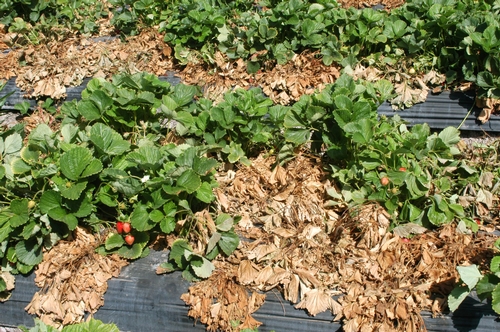
Figure 1. Charcoal rot results in the collapse and death of strawberry plants. Photo Steven Koike, UCCE
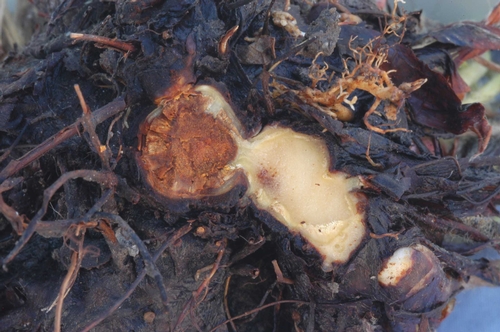
Figure 2. Internal crown tissue of strawberry infected with Macrophomina will show a dark to orange brown discoloration. Photo Steven Koike, UCCE
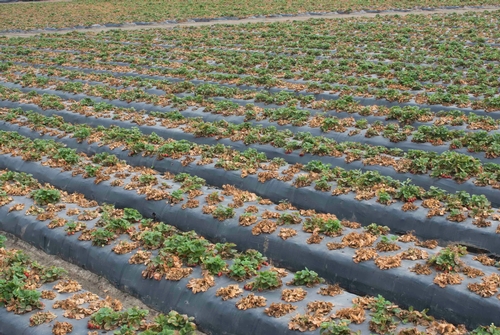
Figure 3. Charcoal rot can affect large portions of a field and cause significant dieback. Photo Steven Koike, UCCE
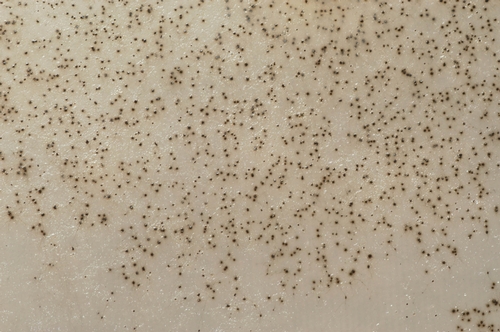
Figure 4. Tiny, black microsclerotia enable the Macrophomina pathogen to survive in the soil. Photo Steven Koike, UCCE
Verticillium Wilt in strawberries: California 2013 Update
Verticillium wilt continues to be one of the most potentially damaging diseases caused by soilborne pathogens in strawberries grown in California. Historically Verticillium was the primary target against which soil pathogen mitigation, i.e. pre-plant soil fumigation, avoidance and crop rotation, and breeding for plant resistance, in strawberries was been directed.
Verticillium wilt symptoms: Early symptoms consist of stunting, delayed development, and the yellowing of lower leaves. As disease progresses the older leaves wilt, dry up, and become brown; typically the younger, central leaves of the plant remain green until the plant dies and all foliage turns brown (Figure 1). In contrast to Verticillium wilt of other crops such as lettuce, vascular discoloration in strawberry crowns may be subtle or absent (Figure 2). Strawberry disease symptoms can be accentuated if the infected plant is subject to stress such as from environmental extremes or mite infestations.
The Pathogen: Verticillium wilt in strawberry is caused by Verticillium dahliae. The host range of this pathogen is quite broad, though in recent years researchers have found sub-groups within V. dahliae that have preferred hosts and therefore narrower host ranges. For strawberry growers, they should be aware that the Verticillium isolates that infect lettuce and artichoke also infect strawberry. Likewise, the strawberry isolates of Verticillium can infect lettuce and artichoke. Verticillium gets its name from the whorls of spore-bearing branches (phialides) that are visible when the fungus is viewed under a light microscope (Figure 3).
Verticillium forms a survival structure, the microsclerotium, which allows the pathogen to survive unfavorable conditions and persist between host crops (Figure 4). Microsclerotia are dense masses of thick, dark (melanized) cells that form inside host tissues and are released into the soil when crop residues break down and decay. Researchers have developed methods for measuring the population of viable microsclerotia in soils; such measurements (microsclerotia per gram of soil [ms/gram]) can give growers and others an estimate of potential threat to strawberry plantings. Strawberry has a very low threshold tolerance for Verticillium. A soil test result of 3 ms/gram likely indicates that some disease may develop on the subsequent strawberry crop. With a soil test result of 10 or more ms/gram, strawberry should probably not be planted unless soil fumigation is planned. The picture below is of a field with an average of 30 ms/gram at the end of July (Figure 5).
Disease Development: Verticillium microsclerotia germinate in the soil when activated by exudates from the host plant roots. Once penetrating the plant root, the fungus grows up into the xylem (the water conducting elements of the plant), degrading the cell walls and most likely releasing toxins. This type of colonization is called a systemic infection. Systemic infections interfere with the plant’s ability to conduct water. For this reason, infected strawberry plants will wilt during times of high water demand, such as during hot and dry weather, if the plant is improperly (too dry) irrigated, or if bearing a heavy fruit load. Diseased plants that show some dieback symptoms may recover if the stress conditions subside; however, such plants are not likely to be as productive as unaffected, healthy plants.
The pattern and distribution of Verticillium wilt disease in the field can be extremely variable and does not necessarily correspond with low spots, heavy soil, or improperly irrigated areas. In contrast, such field conditions may correspond with patterns of Phytophthora crown rot. Instead, many times Verticillium wilt affected plants can be found distributed all over the field, perhaps as individual plants or as patches of affected plants.
Managing Verticillium in Strawberry:
Plant Breeding for Resistance: Strawberry plants genetically resistant to V. dahliae are not yet available commercially. However, resistance should play a big role in the future mitigation of Verticillium wilt in strawberry, though development of completely resistant cultivars has not been easily attained. In a research report (California Agriculture, January/March 2010), it is pointed out that intensive selection for Verticillium resistance resulted in a few genotypes that demonstrated a great amount of resistance when inoculated with the pathogen; however, these selections suffered some yield loss under intense disease pressure. Furthermore, these highly resistant genotypes all expressed “substantial deficiencies for horticultural or productivity traits,” meaning they weren’t producing the quantity or quality of fruit that we have come to expect in California.
Even so, the University of California strawberry breeding program has made significant advances in improving genetic resistance to Verticillium. Starting in the late 1980s, less than 40% of the genotypes used in the UC breeding program had moderate tolerance to V. dahliae; twenty years later, between 80 and 100% of the genotypes used had such tolerance.
Soil treatments: Soil fumigation with a mix of methyl bromide and chloropicrin is usually recommended for conventional growers, but this plan of action is becoming quite expensive if not impossible under new regulations and limitations. Chloropicrin used alone is successful in disinfesting soils of Verticillium, as are mixes of 1,3 – Dichloropropene and chloropicrin (Telone C-35) but generally none of these have been shown to be as effective as methyl bromide and chloropicrin used together in clearing a soil of Verticillium pathogen.
An alternative soil treatment being tested and demonstrated in several commercial fields is anaerobic soil disinfestation (ASD). ASD works by inducing an anaerobic (oxygen-less) condition in soils that are amended with a carbon source. The resulting proliferation of oxygen-consuming microbes shifts the soil ecology and microbial diversity, resulting in suppression of pathogenic organisms. Researchers are continuing to develop and fine-tune this method.
Biofumigation is another soil treatment that can reduce Verticillium numbers in the soil. Broccoli crop residues release chemicals that both directly reduce Verticillium propagules as well as affecting the soil microbial diversity, which can suppress the pathogen. While mustards and other cruciferous plants show similar effects, broccoli appears to be one of the best choices for this soil biofumigation treatment. A crop rotation that includes broccoli will have the same suppressive effect, since the harvested broccoli florets are not needed for biofumigation to take place.
Sanitation: Being a soilborne pathogen, V. dahliae is readily spread between fields in mud and dirt adhering to equipment and vehicles. Growers should therefore beware of moving contaminated equipment from infested fields into “clean” fields. Because diseased strawberry plants are infested with microsclerotia, strawberry crop residues should not be moved into other fields.
Crop rotation: Crop rotation is a key IPM practice that will help lessen the threat from Verticillium wilt. Consecutive, back-to-back plantings of strawberry is a risky practice if the field has a history of Verticillium wilt and if effective fumigants are not used. Fields which have been recently planted to lettuce, artichoke, and Solanaceous family crops (potatoes, eggplants, and tomatoes) should likewise be avoided if Verticillium wilt has occurred and if soil fumigation is not implemented. Weeds that are hosts of V. dahliae may not play a critical role in disease development but should be controlled in any case.
Other alternatives: Another experimental alternative to chemical control is the use of organic substrates, such as coconut peels (coir) or peat moss, which are used as the rooting medium in place of the soil but are kept completely separate from the soil by cloth barriers. The substrates are poured into cloth-lined furrows that are constructed into the beds. The intent of this approach is to create a pathogen-free zone above the field soil. This method is still being tested.
Finally, there are a series of commercially available biological fungicides which purport to competitively exclude pathogenic fungi such as Verticillium from the surface of the root, or which produce toxins inhibitory to pathogen growth. These materials likewise still require research and demonstration of efficacy under field conditions.
The above has been a discussion the biology and management of Verticillium wilt disease in strawberry. There are pesticides mentioned for the management of Verticillium in this article. Before using any of these products, check with your local Agricultural Commissioner’s office and consult product labels for current status of product registration, restrictions, and use information.
(The authors thank K. V. Subbarao for assistance with this report.)
References:
California Agriculture, Jan/Mar 2010. http://californiaagriculture.ucanr.org/landingpage.cfm?article=ca.v064n01p37&fulltext=yes
UC IPM Online, strawberry Verticillium wilt. http://www.ipm.ucdavis.edu/PMG/r734100811.html
UC IPM, Guia para el manejo de las plagas, Fresas. http://www.ipm.ucdavis.edu/PDF/PMG/pmgstrawberry_espanol.pdf
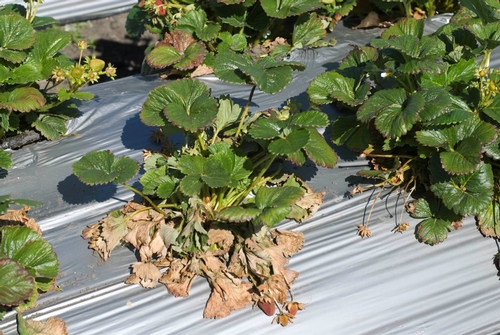
Figure 1: Brown foliage and plant collapse caused by Verticillium wilt. Photo Steven Koike, UCCE.
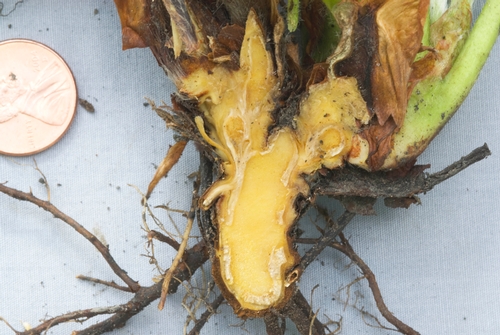
Figure 2. Crown of Verticillium-infected strawberry showing lack of internal crown discoloration.. Photo Steven Koike, UCCE.
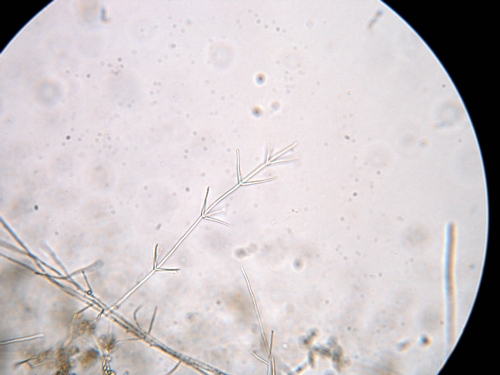
Figure 3. Microscopic view of the verticillate spore bearing structure of V. dahliae. Photo Steven Koike, UCCE.
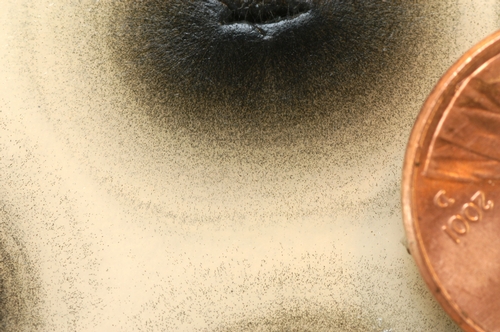
Figure 4. Culture petri dish showing profuse numbers of black microsclerotia. Photo Steven Koike, UCCE.
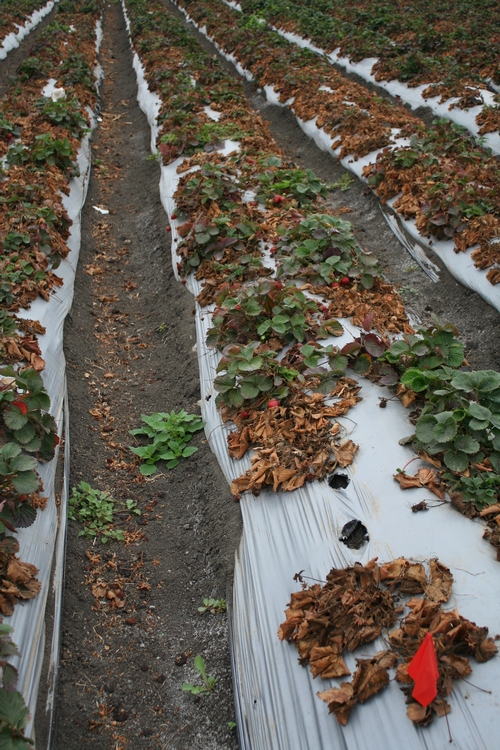
Figure 5. Significant dieback in a field highly infested (30 ms/gram) by V. dahliae. Photo Mark Bolda, UCCE.
A New Way to Manage Weeds in the Anchor Rows of Tunnels
A cover crop can be a useful way to prevent weeds in anchor rows.
Cover crops in anchor rows can suppress weed growth and additionally help to minimize soil erosion and nutrient and sediment loss when it rains. Densely planted cover crops can outcompete weed seedlings germinating from the soil and prevent wind-dispersed seeds from reaching the wet soil surface. Have a look at the newly revised weed section in the Caneberries Pest Management Guidelines on the UC IPM web site.
As readers know, tunnels used for caneberry cultivation have the advantage that even when it rains caneberries remain dry which helps with fruit quality and yield. However, during rains, the water drains from the plastic cover of the tunnel and down into rows that contain the anchoring posts of the tunnel structure. The accelerated runoff in these post rows can cause soil erosion, sediment and nutrient loss. As such, the persistent soil moisture in post rows also promotes weed growth. These weeds, while maybe not competing directly with canes, can reproduce and quickly spread into neighboring cane rows.
Cover crops in the anchor rows are especially helpful when managing weeds that are difficult to control with fumigation because of their hard impermeable seed coats (mallows and filaree), or that have developed resistance to herbicides such as glyphosate and paraquat (hairy fleabane and horseweed).
Cover crops can be managed with mowing or herbicides to avoid seed production.
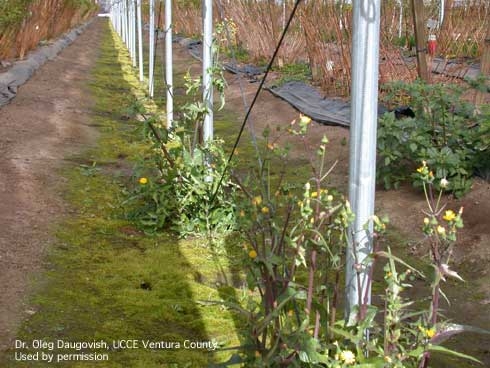
Weeds growing in anchor row in caneberry tunnel production. Photo courtesy Oleg Daugovish, UCCE.
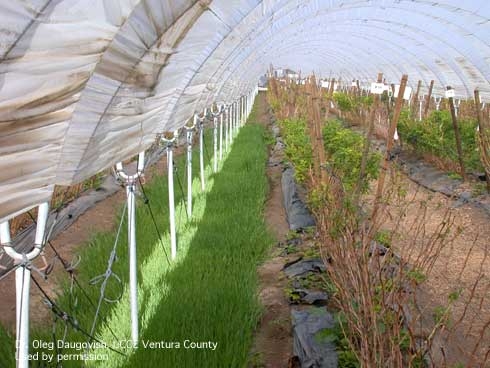
Cover crop growing in the anchor row in caneberry tunnel production. Photo Oleg Daugovish, UCCE.
Data Driven Decision Making: Finding Success in Plant Diagnostics and Stock Speculation
Stock speculation and plant diagnostics are surprisingly similar in the process and attitudes necessary for successful outcomes. In both endeavors, one must address an issue by gathering data about it, assess it correctly and make a decision in a timely matter.
The beauty of the stock market, and the lesson it provides those of us working in other areas of data driven decision making, is how swiftly information that really matters is integrated into the prices of shares. The successful stock operator needs to be constantly mindful of the data capable of influencing the present and future prices of the shares he or she is considering purchasing or selling. Not everything crossing the ticker tape or news crawl on the bottom of the screen is of equal value. Market commentary of the popular punditry and prognosticators is near useless (and potentially dangerous) in making decisions, while unexpected electoral outcomes and even small changes in national bank policy of large economies will have significant effects on markets. The key point is that information of real value is almost instantly reflected in the price of shares, putting the ability to identify the facts and make sound decisions on them quickly at a real premium and quite often will result in profitable speculation.
In the same vein, the effective plant diagnostician should ignore guesses and empty theories all the while taking into full consideration all the possible information about a problem available at that time. Experience tells us that in berries, it is valuable to pay attention to the duration of transplant cold conditioning, planting date, source nursery, type of fumigation or preplant treatment, plant tissue mineral concentrations, soil physical and chemical composition, plant establishment practices, former and current presence/absence of major pests, irrigation practices and fertilizer management.
While in plant diagnostics the practitioner is spared the split second requirement to make a decision as on the stock market, there is still a premium on making sound decisions and acting on them in a timely manner. The effects of unaddressed maladies are incorporated into current and future plant performance rapidly, and so the time to address a problem is nevertheless very soon after the complaint is noticed or received.
In the assessment of the data in reference to making a decision, one of the biggest mistakes a stock speculator and plant diagnostician can make is to create narratives, in other words stories, to explain what is occurring. Narratives have been a wonderful mechanism for humans to understand and survive in a constantly changing and bewildering world, but they can also lead to the creation of dangerous and misleading fictions, which elevate some information over other data vital to a true picture of what is really happening.
Take for example the rush to buy gold on the part of many investors over the past few years. Historic levels of Federal Reserve monetary activity through the release of billions and billions of dollars into circulation concurrent with significant government intervention in the economy compelled some investors to create a narrative of impending hyperinflation, and had them seeking refuge in the supposed store of eternal value in gold. This narrative of roaring inflation in the near future blinded many to the fact that through this entire time, the prices of Treasury bonds, which are a measure of the market's faith in the US government along with being extremely sensitive to and wary of inflation, were hitting all time highs in price arising from unprecedented demand. This cherry picking of facts and the creation of a story by some market participants resulted in a pretty decent bubble in gold for several years but now whose fiction has been cruelly exposed by the sharp drop in gold prices over the past two months (Figure 1 below).
Similarly, approaching a berry field and creating a narrative by focusing on and elevating one factor and ignoring the many other possibilities can result in a mistaken or incomplete diagnosis. Just because you find a pest or identify one problem doesn't necessarily mean that's all of it.
Take for example the issue of yellow leaves in strawberries (Figure 2 below) and caneberries. It has been a habit to simply refer yellowed leaves to some nutritional deficiency such as nitrogen, iron or zinc. A simple check in the literature or the web shows that indeed leaves can become yellow when one of these vital minerals is lacking, but which one? Furthermore, let me assure you as a person who makes a lot of diagnostic field visits that there are many, many causes of yellowing of strawberry and caneberry leaves! Each case really needs to be fully investigated on its own merits, lest the cure applied is not the right one, allowing valuable time to slip by and the plant declines further in yield potential or ends up wilting and dying. Much as the narrative-creating gold bugs in the above example lost vast sums of money in the recent sell off, growers acting on the narrative that iron is the cause of a given case of yellowed leaves because that's the way it looks in the book and then going on to ignore all of the other things in that field are going to get hit with a big loss if it turns out to be something else.
I would like to close this article with a note about proper attitude. As human as it is to err, it is even more human to not want to admit to making mistakes. Both plant diagnosticians and stock speculators must be able to neutrally approach their craft, because stubbornness and an inability to admit being wrong means you have mentally blocked out the possibility of making any decision other than the one to which you have attached yourself. It's very hard for many of us to fess up to a mistake because it's embarrassing or we are emotionally attached to our theory or whatever, but the net result of this inability to make the necessary change in attitude to agree with what is truly happening will be a failure to achieve the right solution to the real problem.
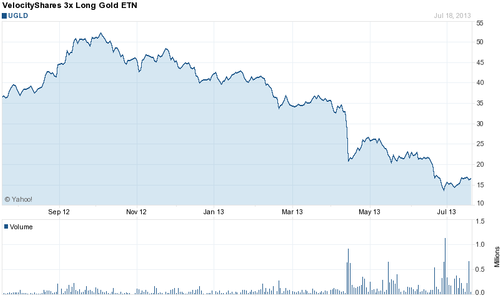
Figure 1: Dude, what happened to my gold fund?
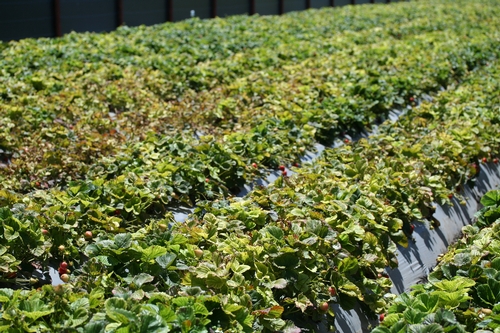
Figure 2: Are these plants really short of iron?
Viruses of Strawberry in 2013
A number of instances of underperformance and strawberry plant collapse in Santa Maria and Salinas along with the identification of the viruses responsible have brought around attention to this aspect of plant pathology in strawberry:
//ucanr.edu/blogs/blogcore/postdetail.cfm?postnum=10773
To add to this fine article, three weeks ago I had the good fortune to attend with my colleague Steve Koike a seminar given by University of Arkansas virologist Dr. Ioannis Tzanetakis. The theme was viruses in blackberries, but we learned a few important principles associated with viruses in berries in general.
Three topics of interest:
Titer of virus in contrast to its identification: A key point brought up was that the type of each virus is less important to the plant response than its very presence and titer (concentration). In other words, the response of the plant is correlated stronger to the total amount of virus present rather than to their taxonomy. Importantly, virus infections which are expressed like this additively would be seen in the field as plants having heavy exposure expressing more severe decline than those which have less. Therefore, symptoms would be manifested over a range, rather than simply just dead plants or live plants.
Viral transmissibility by vectors varies. We discussed the 2003 virus decline in Watsonville and Salinas strawberries resulting from an association of strawberry pallidosis and beet pseudo yellows virus along with twelve other viruses.
USDA- ARS virologist Dr. Bill Wintermantel, who pointed out that at a success rate around 80%, strawberry pallidosis is very transmissible by whiteflies, but since the background levels are usually low it doesn’t get moved around very much even though it transmits so easily. However, when an area like the fields along the coast in Watsonville in 2003 and then again in certain areas of Guadalupe last fall are swamped with the huge inflows of whiteflies as they did, even a low percentage of pathogen in the background doesn't matter because the low probability of transmission is overwhelmed by the number of attempts and the odds of success rise greatly.
Beet pseudoyellows virus, which was part of the problem in 2003, but not in 2013 apparently, has a far lower rate of transmissibility by whiteflies. However, since the background levels are so high in many local weed and crop plant species, it again has fair odds of getting moved around when the numbers of whiteflies are high.
Virus infection of strawberries the Eastern United States: Dr. Tzanetakis expanded on the topic of viruses in strawberry by talking about the virus infection this past season in Florida and several other states of the Eastern USA. The infection was traced back to a single nursery in Nova Scotia which was situated next an untreated commercial field and virtually 100% of the plants were later found to be infected with strawberry mild yellow edge virus (SMYEV) and strawberry mottle virus (SMoV), both of which are aphid transmitted.
More from Growing Produce online:
http://www.growingproduce.com/article/34043/strawberry-virus-alert

